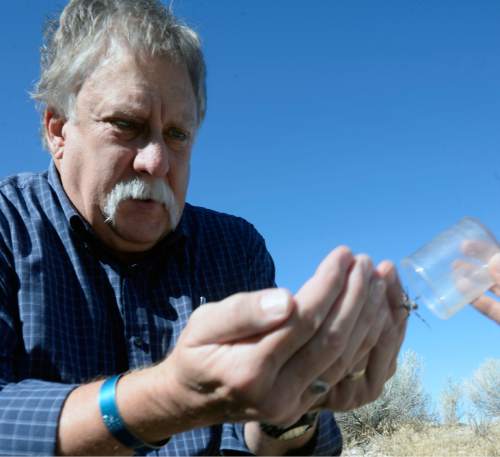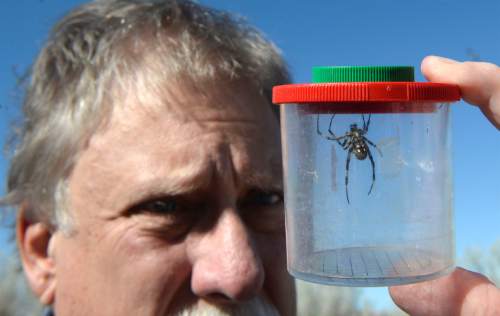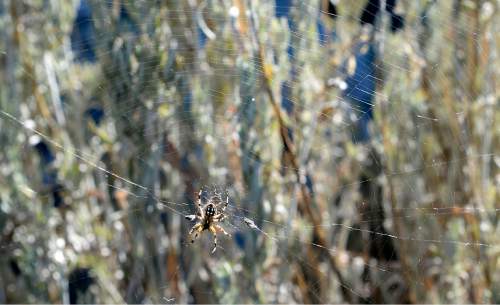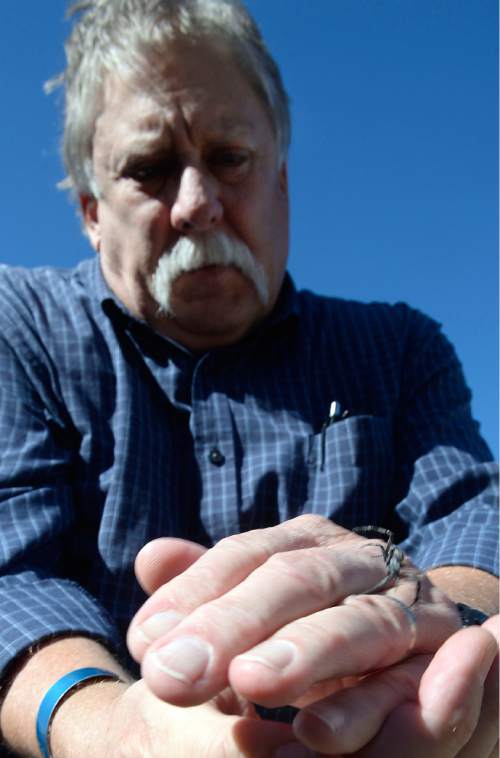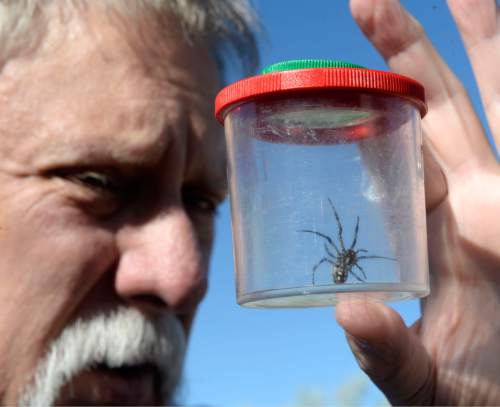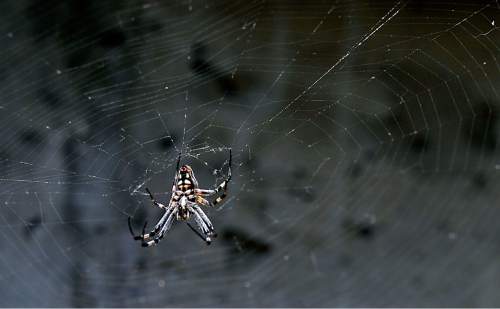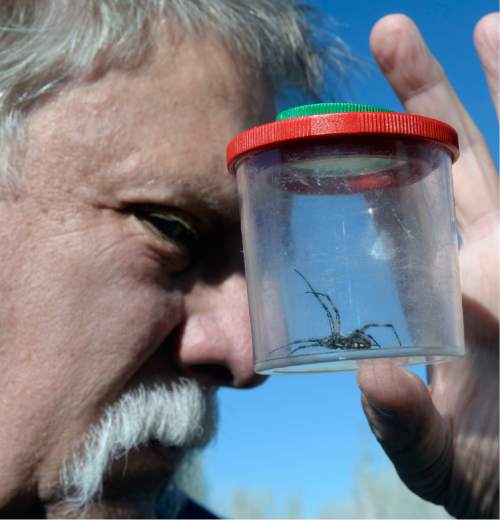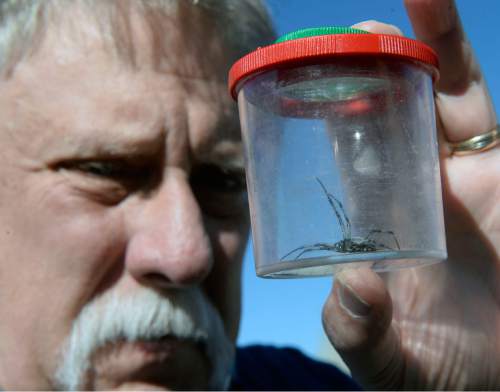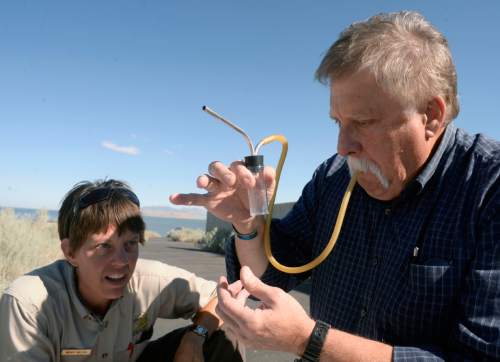Al Hartmann | The Salt Lake Tribune
Robert Kirby, tries holding a just caught Western Spotted Orb Weaver spider in his hands b
Al Hartmann | The Salt Lake Tribune
Antelope Island Sate Park ranger-naturalist, Charity Owens, left, and Wendy Wilson, Assista
Al Hartmann | The Salt Lake Tribune
Robert Kirby, eyeballs a Western Spotted Orb Weaver spider caught on a spider hunt just out
Al Hartmann | The Salt Lake Tribune
A Western Spotted Orb Weaver spider hangs in its web just outside the visitors center at An
Al Hartmann | The Salt Lake Tribune
Robert Kirby, tries holding a just caught Western Spotted Orb Weaver spider in his hands b
Al Hartmann | The Salt Lake Tribune
Robert Kirby, eyeballs a Western Spotted Orb Weaver spider caught on a spider hunt just out
Al Hartmann | The Salt Lake Tribune
A Western Spotted Orb Weaver spider hangs in its web just outside the visitors center at An
Al Hartmann | The Salt Lake Tribune
Robert Kirby, eyeballs a Western Spotted Orb Weaver spider caught on a spider hunt just out
Al Hartmann | The Salt Lake Tribune
Wendy Wilson, Assistant Park Manager at Antelope Island State Park looks on with concern or
Al Hartmann | The Salt Lake Tribune
Antelope Island Sate Park ranger-naturalist, Charity Owens, left, Wendy Wilson, Assistant P
Al Hartmann | The Salt Lake Tribune
A Western Spotted Orb Weaver spider hangs in its web outside window at the visitors center
Al Hartmann | The Salt Lake Tribune
Robert Kirby, eyeballs a Western Spotted Orb Weaver spider caught on a spider hunt just out
Al Hartmann | The Salt Lake Tribune
Wendy Wilson, Assistant Park Manager at Antelope Island State Park looks on with concern or
Al Hartmann | The Salt Lake Tribune
A Western Spotted Orb Weaver spider hangs in its web just outside the visitors center at An
Al Hartmann | The Salt Lake Tribune
Robert Kirby, tries holding a just caught Western Spotted Orb Weaver spider in his hands but they are incredibly fast and don't hang around long. It's by his ring finger at lower right. The fourth-annual SpiderFest at Antelope Island will be a chance to learn,and get up close and personal with some arachnids.
Al Hartmann | The Salt Lake Tribune
Antelope Island Sate Park ranger-naturalist, Charity Owens, left, and Wendy Wilson, Assistant Park Manager, go on a spider hunt looking for Western Spotted Orb Weaver spiders just outside the vistors center. They actually found them everywhere in the vegetation and rocks. The fourth-annual SpiderFest at Antelope Island will be a chance to learn,and get up close and personal with some arachnids.
Al Hartmann | The Salt Lake Tribune
Robert Kirby, eyeballs a Western Spotted Orb Weaver spider caught on a spider hunt just outside the visitors center at Antelope Island State Park. Not to worry, they aren't poisonous. They are everywhere in the vegetation and rocks when you start to look. The fourth-annual SpiderFest at Antelope Island will be a chance to learn and get up close and personal with some arachnids.
Al Hartmann | The Salt Lake Tribune
A Western Spotted Orb Weaver spider hangs in its web just outside the visitors center at Antelope Island State Park. Not to worry, they aren't poisonous. They are everywhere in the vegetation and rocks when you start to look. The fourth-annual SpiderFest at Antelope Island will be a chance to learn and get up close and personal with some arachnids.
Al Hartmann | The Salt Lake Tribune
Robert Kirby, tries holding a just caught Western Spotted Orb Weaver spider in his hands but they are incredibly fast and don't hang around long. It's by his ring finger at lower right. The fourth-annual SpiderFest at Antelope Island will be a chance to learn,and get up close and personal with some arachnids.
Al Hartmann | The Salt Lake Tribune
Robert Kirby, eyeballs a Western Spotted Orb Weaver spider caught on a spider hunt just outside the visitors center at Antelope Island State Park. Not to worry, they aren't poisonous. They are everywhere in the vegetation and rocks when you start to look. The fourth-annual SpiderFest at Antelope Island will be a chance to learn and get up close and personal with some arachnids.
Al Hartmann | The Salt Lake Tribune
A Western Spotted Orb Weaver spider hangs in its web just outside the visitors center at Antelope Island State Park. Not to worry, they aren't poisonous. They are everywhere in the vegetation and rocks when you start to look. The fourth-annual SpiderFest at Antelope Island will be a chance to learn and get up close and personal with some arachnids.
Al Hartmann | The Salt Lake Tribune
Robert Kirby, eyeballs a Western Spotted Orb Weaver spider caught on a spider hunt just outside the visitors center at Antelope Island State Park. Not to worry, they aren't poisonous. They are everywhere in the vegetation and rocks when you start to look. The fourth-annual SpiderFest at Antelope Island will be a chance to learn and get up close and personal with some arachnids.
Al Hartmann | The Salt Lake Tribune
Wendy Wilson, Assistant Park Manager at Antelope Island State Park looks on with concern or incredulity as Tribune's Robert Kirby tries to get the hang of sucking up tiny spiders with a medical aspirator device during a spider hunt. Kirby calls it the "spider bong." The first attempt sucking up spiders he used the wrong end of the "spider bong" and one ended up in his mouth. Good thing it wasn't the poisonous kind. He actually got one here in the container instead of his mouth. The fourth-annual SpiderFest at Antelope Island will be a chance to learn,and get up close and personal with some arachnids.
Al Hartmann | The Salt Lake Tribune
Antelope Island Sate Park ranger-naturalist, Charity Owens, left, Wendy Wilson, Assistant Park Manager, and Tribune's Robert Kirby go on a spider hunt looking for Western Spotted Orb Weaver spiders just outside the vistors center. They actually found them everywhere in the vegetation and rocks. The fourth-annual SpiderFest at Antelope Island will be a chance to learn,and get up close and personal with some arachnids.
Al Hartmann | The Salt Lake Tribune
A Western Spotted Orb Weaver spider hangs in its web outside window at the visitors center at Antelope Island State Park. Not to worry, they aren't poisonous. They are everywhere in the vegetation and rocks when you start to look. The fourth-annual SpiderFest at Antelope Island will be a chance to learn and get up close and personal with some arachnids.
Al Hartmann | The Salt Lake Tribune
Robert Kirby, eyeballs a Western Spotted Orb Weaver spider caught on a spider hunt just outside the visitors center at Antelope Island State Park. Not to worry, they aren't poisonous. They are everywhere in the vegetation and rocks when you start to look. The fourth-annual SpiderFest at Antelope Island will be a chance to learn and get up close and personal with some arachnids.
Al Hartmann | The Salt Lake Tribune
Wendy Wilson, Assistant Park Manager at Antelope Island State Park looks on with concern or incredulity as Tribune's Robert Kirby tries to get the hang of sucking up tiny spiders with a medical aspirator device during a spider hunt. Kirby calls it the "spider bong." The first attempt sucking up spiders he used the wrong end of the "spider bong" and one ended up in his mouth. Good thing it wasn't the poisonous kind. He actually got one here in the container instead of his mouth. The fourth-annual SpiderFest at Antelope Island will be a chance to learn,and get up close and personal with some arachnids.
Al Hartmann | The Salt Lake Tribune
A Western Spotted Orb Weaver spider hangs in its web just outside the visitors center at Antelope Island State Park. Not to worry, they aren't poisonous. They are everywhere in the vegetation and rocks when you start to look. The fourth-annual SpiderFest at Antelope Island will be a chance to learn and get up close and personal with some arachnids.


